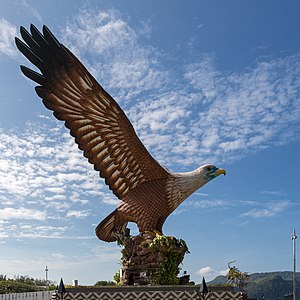
GUARDINI DOES IT AGAIN
11 MARCH 2015
 KUALA
BERANG : Andrea Guardini again proved unstoppable in a bunch spritn
when the Astana Pro Team rider took his third win of Le Tour de Langkawi
(LTdL) 2015 in a bunch sprint in Stage Four from Kota Baru to Kuala
Berang today.
KUALA
BERANG : Andrea Guardini again proved unstoppable in a bunch spritn
when the Astana Pro Team rider took his third win of Le Tour de Langkawi
(LTdL) 2015 in a bunch sprint in Stage Four from Kota Baru to Kuala
Berang today.
Guardini, 27, beat Team
Southeast's Jakub Mareczko to the finish line, with Orica-GreenEdge's
Caleb Ewan finishing third this time but held on to both the overall
general classification and points classification leads. This was also
Guardini's 17th ever win in the race's history, extending even further
his already impressive record.
"I am happy with the way the
sprint went. I managed a really good sprint to take this win. Today was a
really fast paced stage with the speed in the earlier part already very
high at 50 to 60 kp/h," said Guardini.
"I then had a good lead-out and I
took a good risk, then the job was done. For the moment, this is a good
result. But for now, I think I can do more than this."
A five-man breakaway of United
Healthcare's Jonathan Clarke, Bretagne-Seche Environnement's Pierre-Luc
Perichon, Synergy Baku's Elchin Asadov, Skydive Dubai's Vladimir Gusev
and Pegasus Jamalidin Novardianto escaped the peloton after 30km of the
165km stage and they took all the intermediate points on offer for the
day before the peloton caught them 2km from the finish.
Ewan lost out to Guardini and had
to settle for third this time, but was not raising his hopes to much
when asked about his chances of keeping the overall lead to the end of
the race.
"I climbed well yesterday and
tried to just stay in the group. But I'm not really a pure climber. I
prefer to sprint. It depends on the day. If I feel good on the day, then
I can climb well, but if I don't then it will be the other way around,"
said Ewan, who won Stage 3 yesterday after surviving the tough climb
across the summit of Titiwangsa.
United Healthcare's Kiel Reijnen
retained the mountains classification lead, as did Asian riders
classification leader Zhang Wen Long of the Giant-Champion System team.
Stage Five is the longest stage
of the race at 200km from Kuala Terengganu to Kuantan with coastal
crosswinds and undulating terrain providing a different challenge to the
peloton, which could provide an opportunity for a differnet rider to
take the top step of the podium.
STAGE 4 - Stage Result
Kota Bharu - Kuala Berang 11 March 2015
| PL | No. | Nat | Name | TM | Team | Time |
|---|---|---|---|---|---|---|
| 1 | 1 | ITA | Guardini,Andrea | AST | Astana Pro Team | 3h43’14" |
| 2 | 85 | ITA | Mareczko,Jakub | STH | Southeast | 3h43’14" |
| 3 | 21 | AUS | Ewan,Caleb | OGE | Orica Greenedge | 3h43’14" |
| 4 | 65 | ALG | Reguigui,Youcef | MTN | MTN - Qhubeka | 3h43’14" |
| 5 | 75 | USA | Hanson,Kenneth | UHC | UnitedHealthCare Pro Cycling | 3h43’14" |
| 6 | 113 | MAS | Salleh,Harrif | TSG | Terengganu Cycling Team | 3h43’14" |
| 7 | 17 | AUS | Sutton,Christopher | SKY | Team Sky | 3h43’14" |
| 8 | 193 | TUN | Chtioui,Rafaa | SKD | Skydive Dubai Pro Cycling Team | 3h43’14" |
| 9 | 143 | UKR | Surutkovych,Oleksandr | BCP | Synergy Baku Cycling Project | 3h43’14" |
| 10 | 124 | JPN | Komori,Ryohei | AIS | Aisan Racing Team | 3h43’14" |





